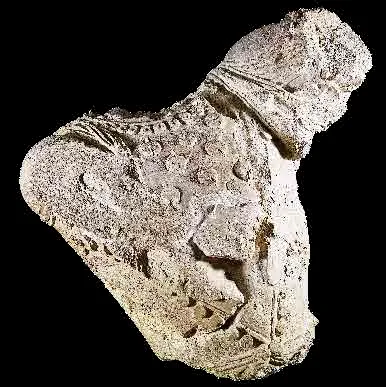
The remarkable works of early medieval art preserved and exhibited in the Museum include one of the scenes of the multi-figure composition of the Red Hall, as well as fragments of a carved ganch from Varakhsha – a medieval village where the remains of the palace of the Bukhara oasis rulers – the Bukhar Khudahs – were found. The honour of discovering and publishing these magnificent findings belongs to the outstanding Uzbek orientalist and archaeologist V. A. Shishkin, who supervised the excavations on the settlement carried out intermittently from 1937 to 1954. In 1986, under the supervision of G. V. Shishkina, the works were resumed by the Central Asian archaeological expedition of the State Museum of Oriental Art (Moscow) and the Bukhara Local History Museum. They lasted until 1991. The excavation of the settlement of Varakhsha, located in the western part of the Bukhara region, was of immense significance, as for the first time in Central Asia wall paintings and carved ganch were found in such a big a mount. T he results o f the work and a detailed analysis of the findings are published in the monograph by V. А. Shishkin. It should be noted that there is not a single significant work on the history of Central Asian art that does not mention the Varakhsha murals and ganch. A detailed study of the Varakhsha ganch in recent years has been dealt with by T. G. Tsvetkova (Alpatkina); A. I. Naymark published an ingenious and convincing interpretation of the decor and adjustment of its date.

In the 8th volume of the series “Cultural Legacy of Uzbekistan”, L. Yu. Kulakova published data on Varakhsha, its murals and ganch decorations.
As we know, the murals of room 11 or the Red Hall are distributed among several museums. A scene depicting the attack of two leopards on a rider and a handler sitting on an elephant kept in the Museum of Arts decorated the western wall and was located on the left part of the wall. Only this scene preserved, at least in part, the face of the chief rider, finely painted by the artist, in which according to the outstanding researchers of the culture and art of Sogdiana A. M. Belenitsky and B. I. Marshak we see the already-familiar Adbag, the supreme deity of the Sogdians. A. I. Naymark, in turn, suggested that the iconography of the bodhisattva Samantabhadra, who loved riding around on an elephant, could serve as a prototype to the image, and here is most likely depicted the Lord of the South who is another character of Buddhist mythology.
The repetitive scenes of the battle of the “righteous king” with monsters (griffins and dragons) and giant cat-like predators are, in general, completely untypical for Sogdian art with its narrative character. A. I. Naymark cleverly explains the desire of the customer, namely the Bukhar Khudah Toghshada ibn Bidun (709 – 738), to allegorically show his uneasy position when he was forced to balance between faith and the centuries-old traditions of his ancestors on the one hand, and the power of the Arabs, who demanded loyalty from him, on the other. Moreover, according to the “History of Bukhara” by Narshakhi, he converted to Islam on the order of the conqueror of Transoxiana Qutaiba ibn Muslim, but secretly remained an adherent of the old faith. We believe that A. I. Naymark’s assumption is right, for the role of the heroic ruler fighting off monsters from all sides perfectly suits Toghshada, who managed to maintain his power for 30 years.
You can learn more about this topic in the book-album “The Collection of the State Museum of Arts of Uzbekistan” (Volume XIII) from the series “Cultural legacy of Uzbekistan in the world collections”.
The general sponsor of the project is the oilfield services company Eriell-Group.
